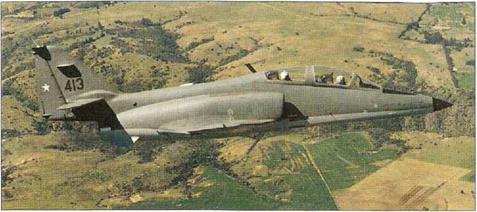BAE SYSTEMS Nimrod Maritime patrol/special missions aircraft
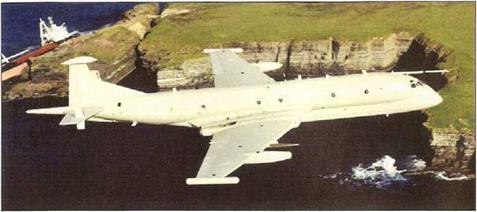
|
T |
he British Aerospace/BAe (Hawker Siddeiey) Nimrod was developed from the Comet airliner as a replacement for the Avro Shackleton. Development began in 1964, when two Comet 4-Cs were converted to serve as prototypes with tai MAD ‘stinger’, nose-mounted search radar and a fin-tip ESM football. A new 14,78-m (43-ft 6-in) long ventral weapons bay was added, giving a distinctive ‘double – bubble’ cross-section. The first Spey-powered prototype made its maiden flight on 23 May 1967. Forty six Nimrod MR. Mk 1s were ordered with the type entering service in October 1969.
Seven airframes were substantially modified to Nimrod AEW. Mk 3 standard, wTh Marconi AEW radar housed in huge radomes at either end of the fuselage. The ill-fated project was cancelled in 1986 following radar development problems.
From 1975 the 35 remaining MR. Mk 1s were upgraded to MR. Mk 2 configuration with a new central tactical system. Searchwater radar and new communications equipment. Operation Corporate in 1982 added IFR probes and undenting weapons pylons, resulting in the designation MR. Mk 2P. All aircraft now have wingtip Loral ESM pods and can carry BOZ 100 chaff dispenser pods and/or the Ariel towed radar decoy for added self-protection.
A single Nimrod MR. Mk 2P was painted in this overall grey camouflage schemej but the scheme has not been adopted by the rest of the fleet.
The RAF’s Nimrod are all based at RAF Kinloss, in Scotland, where they are divided among the four squadrons of the Kinloss Wing.
Three aircraft were ordered as Nimrod R. Mk 1 {later R. Mk IP) intelligence-gathering platforms to serve with the RAF’s dedicated special reconnaissance unit. No. 61 Squadron. These aircraft have no MAD tailboom and no searchlight. Instead they have been fitted with dielectric radomes in the nose of each external wing tank and on the tailcone. The aircraft have been progressively modified since they were introduced, gaining additional antennas above and below the fuselage and wing tanks, as well as Lorai wingtip ESM pods. A Nimrod MR. Mk 2 was converted to R. Mk 1 standard when one of the original R. Mk 1s crashed in 1995.
In 1996 the RAF chose to upgrade 21 existing Nimrods to Nimrod MRA. Mk 4 (Nimrod 2000! standard, to meet its future maritime patrol needs. The modified Nimrods will be re-engined with four ‘marinised’ 68.9-kN (15,500-lb) Rolls-Royce BR710 turbofans (necessitating a rebuilt wing box and wing inner panels), fitted with an entirely new advanced mission system and expanded weapons capability. The Nimrod MRA. Mk 4 programme is expected to extend aircraft life by another 25 years, however severe engineering delays have put back the type’s intended service entry date from December 2000 to March 2005.
Specification: BAE SYSTEMS Nimrod MR. Mk 2P
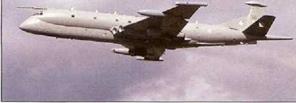 Powerplanr. four 54-kN (12,140-lb) Rolls – Royce RB. 168-20 Spey Mk 250 turbofans Dimensions: soan 33 m (114 ft 10 in), length 38,63 m| -?6 ft 9 in}; height 9.08 m (29 ft 8.5 in) Weights: typical empty 39010 kg 186,000 lb); maximum normal take-off B0514 kg (177,500 lb); Performance: maximum cruising Speed 880 kfJlh (547 mph): economica: cruising speed at optimum altitude 787 kmh [490 mph}; typical patrol speed at low level 370 kmh (230 mph) on two engines; service ceiling 12800 m (42,000 ft); maximum endurance 15 hours Armament maximum ordnance 6124 kg (13,500lb)
Powerplanr. four 54-kN (12,140-lb) Rolls – Royce RB. 168-20 Spey Mk 250 turbofans Dimensions: soan 33 m (114 ft 10 in), length 38,63 m| -?6 ft 9 in}; height 9.08 m (29 ft 8.5 in) Weights: typical empty 39010 kg 186,000 lb); maximum normal take-off B0514 kg (177,500 lb); Performance: maximum cruising Speed 880 kfJlh (547 mph): economica: cruising speed at optimum altitude 787 kmh [490 mph}; typical patrol speed at low level 370 kmh (230 mph) on two engines; service ceiling 12800 m (42,000 ft); maximum endurance 15 hours Armament maximum ordnance 6124 kg (13,500lb)
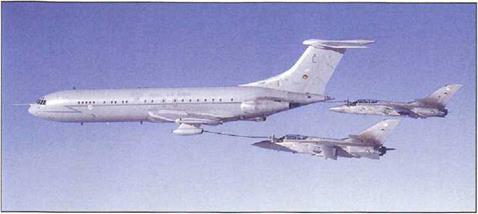
|
M |
odification of the civil Vickers/BAC VC10 airliner into a transport gave the RAF useful passenger and cargo-carrying capacity. Meeting a 1960 specification for a strategic long-range transport for the RAF’s Transport Command, the first military VC10s were similar to the civil Standard VC10 but were featured uprated Conway engines, the Super VCIO’s additional fin fuel cell, rearward-facing seats, a side-loading freight door, an IFR probe and an APU in the tail cone. As the VC10 C. Mk 1 the aircraft incorporated seating capacity for up to 150 passengers or 76 stretcher cases and six medical attendants, The first of 14 RAF VClQs made its maiden flight in November 1965 and initial deliveries began in July 1966. No. 10 Squadron was the sole C. Mk 1 operator and undertook regular route flights from April 1967. Carrying less than half its full payload, the VC10 had a range exceeding 8047 km (5,000 miles),
In 1978 a programme was initiated to convert surplus VC10 airliners into tankers, to augment the Victor K. Mk 2 fleet, Five Standard VC10 Series 101s and four Super VC10 Series 1154s were converted to become VC10 K. Mk 2s and VC10 K. IVfk 3s, respectively. These aircraft were fitted with extra fuel tanks in the cabin, three hose-and-drogue units (HDUs) – two underwing and one in the rear fuselage – and a closed-circuit television system for monitoring of refuelling operations. The K. Mk 3 also had an additional fuel tank in the fin. The first VC10
The VC10 K. Mk 2 was the first of the VC10 tanker family to be completely retired. This No. 101 Sqn aircraft is seen refuelling two Tornado F. Mk 3s.
K. Mk 2s joined No. 101 Squadron a: Brize Norton in May 1984, with the first K. Mk 3s following in 1985. Four years later another five Super VClOs were converted to short-range VC10 K. Mk 4 tanker standard, The VC10 K. Mk 4s have Mk 17 and Mlk 32 m-fiight refuelling pods, closed-circuit TV, air-to – air TACAN, avionics systems and the same engines as the VC10 K. Mk 3, but no cabin fuel tanks.
To augment the dedicated tanker fleet, eight of the VIP-tasked VC10 C. Mk 1 transports were upgraded to VC10 C. Mk 1[K) standard. Beginning in 1990, This process retained the full passenger – and freight-carrying capability, but introduced two Flight Refuelling Mk 32 underwing hose-and-drogue pods. In 1992 it was decided to convert 13 C. Mk 1s to C. Mk 1(K> configuration, with the last regular C. Mk 1 leaving service in 1995 for its rework.
The RAF is now accelerating the retirement of the VC10 fleet with the intention of replacing it, and ultimately the TriStar tanker fleet, with a contractorised air-to-air refuelling service supplied under the Future Strategic Tanker Aircraft programme.
Engaged in Eurofighter tanking trials, this VC 10 is wearing the toned-down grey scheme that has replaced the earlier hemp finish applied to the fleet
|
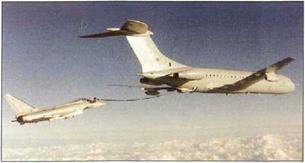
Spain
![]() Basic trainer and light attack aircraft
Basic trainer and light attack aircraft
|
|
D |
esigned by CASA with assistance from MBB ard Northrop, the C.101 Aviajet has been built as a trainer and light strike aircraft. The firs; prototype made its maiden flight on 27 June 1977. Des gn features include an unswept wing with fixed eading edge and shotted flaps, a single Garrett (AlliedSignal) TFE731 turbofan and a stepped cockpit with tandem ejection seats. The Spanish air force purchased two batches of 60 and 28 TFE-731 -2-2J-powered C.101EB-01 trainers, as the E.25 Mirlo (Blackbird). All have hardpoints, but these are not used. A nav/attack system modernisation was introduced on a I C. IOIEBs oetween 1990 and 1992.
The C.101BB attack/trainer introduced an uprated TFE731-3-3„: engine ard was exported as the С. Ю1ВВ-02 to Chile. These aircraft nave six underwirg hardpoints and a :erge underfuseiage bay beneath the rear cockpit, whicn car house a gun pack or other stores. Four C.101 BB-03s were delivered to Honduras.
The dedicated attack variant, the C.101CC, first flew on 16 November 1983 arc is powered oy a TFE731-5-1J engine with a higher military power reserve. The C.101CC has a greater fuel load than earlier versions, – houch no: an increased weapons payload. Jordan received 16 C.101CC-04s for advanced training.
In May 1985 CASA flew the prototype TFE731-5- U-engned C.101 DD Aviojet This a:tack-optimised node! ntroduced improved navigation systems, a weapon-aiming computer, and a Ferrarti HUD. It also had HOTAS controls, an ALP-66 RWR and a Vinten chaff/flare dispenser, and was compatible with Maverick missiles. Intended as an improved trainer ard light attack aircraft, it did not attract any orders, though CASA did offer a variant for the USAF/US Navy JPATS competition.
In Chile, the state manufacturer ENAER built and Developed severa: versions of the Aviojet. Beginning in 1980 ENAER began to assemble C.101 BB-023, under the local designation T-36. These aircraft were fitted with a ranging radar in the nose and were used for advanced tactical training. Four were built by CASA, followed oy 10 ENAER-built examples. In 1986 they were upgraded то A-36BB standard.
The ENAER A-36CC Halcan (C.101 CC-02) was a
dedicated I ght attack version, powered by a TFE731-5 engine. Four were built by CASA, followed by another 19 ENAER-built Halcdns (‘hawk’). uNAER developed a single A-36M orototyoe as a Sea Eag e-amned maritime attack a ircraft, but the programme was shelved.
 Specification: CASA C.101 CC Aviojet Powerplant: one 70.91 – kN J4.,rOO-lb) Garrett TFE731 -5-1J turbofar
Specification: CASA C.101 CC Aviojet Powerplant: one 70.91 – kN J4.,rOO-lb) Garrett TFE731 -5-1J turbofar
Dimensions: span 10 60 m (34 ft 97 in); ergti 12.50 m (41 ft), height 4.25 m (13 ft 11/ in); Weights: empty anuipped 3cCC kg (7,716 lb): maximum take-off ЄЗС0 kg (13.889 lb} Performance: maximum level saeed BOG kmn (501 inch!: maximum mis of climb at sea evei U94 n (4.903 ftl per minute, sen-ice ceiling 12800 ri! (42,000 ft); cumbat radius 519 km [322 miles) on з b-lo-lo interdiction missior with one cannon pnd and lour 250-kg (551-lb) bombs Armament: provision fora twin Browning М3 C.53-H machire-gun pack with 220 rpg; maximum nrdranen 2253 <g (4,963 lb)











